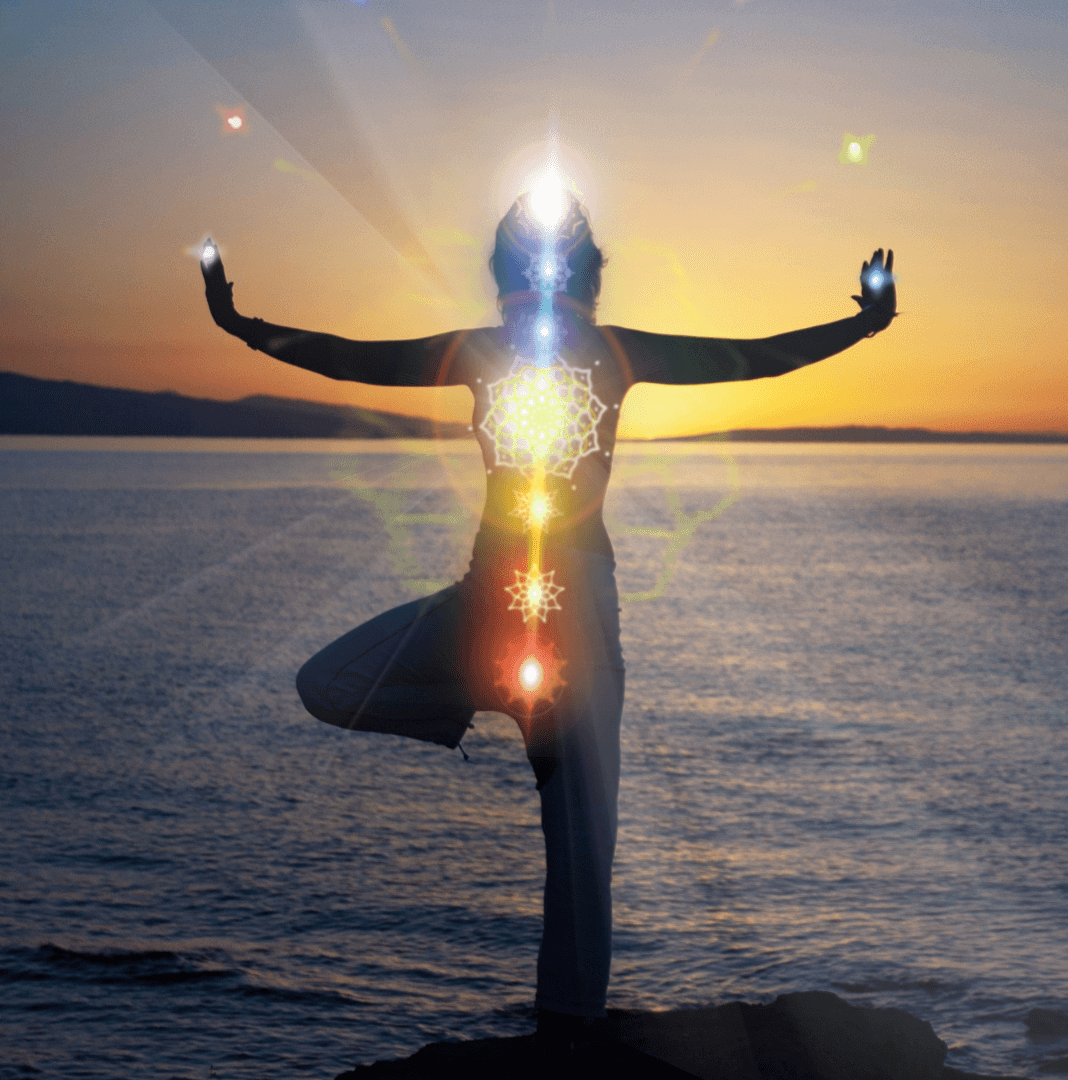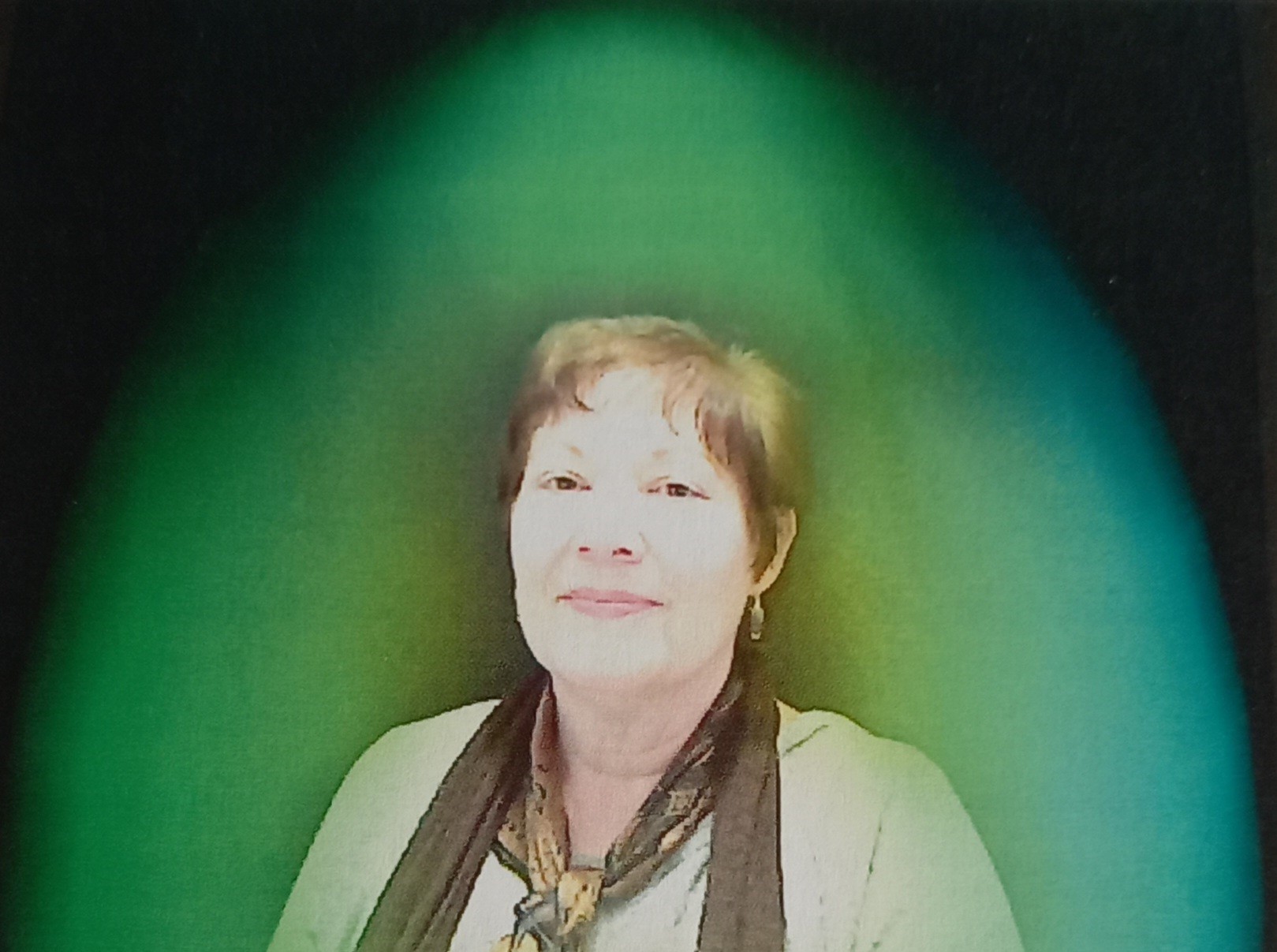Part Three of Four, based on The Spirit of Health: Mind-to-Toe Self-Care for Women
…the Power of the World always works in circles, and everything tries to be round… The sky is round…the Earth is round like a ball, and so are all the stars.The wind, in its greatest power, whirls. Birds make their nests in circles…even the seasons form a great circle in their changing,and always come back again to where they were.The life of man is a circle from childhood to childhood,and so it is in everything where power moves.”
Black Elk (1863-1950) Oglala Sioux holy man
Black Elk summed it up beautifully when he described life as a circle. The term chakra is Sanskrit for “wheel,” meaning a circle or sphere of energy. Take a look at the circular nature of life surrounding you, because literally and figuratively we are surrounded by circles. The atom, the womb and the embryo are all circular. When we are born, we join the circle of a family, and expand into our circle of friends and a circle of community with the world, until ultimately we return again to the Earth. The American Indians called this “the hoop of life.” The worldwide web is a circle of human communication. When two people come together, their union is symbolized with a circle—a ring. The most powerful of religious symbols, Webster’s Dictionary, defines the “circle” as a “ring or halo.” The word “symbol” itself means, “to link two things together.”
Psychologist C.G. Jung said that to contemplate the circle is to contemplate the self. The mandala is still another symbolic circular representation. The word “mandala” is Sanskrit for “circle.” Mythologist Joseph Campbell said that a mandala is symbolically designed to reflect the cosmic order. Observe the cover of this book and you will see Cathy Dyer’s beautiful artistic depiction of the chakras encircled within a mandala. (More of Dyer’s artwork is shown in the “Prayer” chapter of the beautiful book, Mandala: Journey to the Center, by Bailey Cunningham. Check out Cathy’s website www.mandalasawakening.com )
CHAKRAS Chakras are spinning circular wheels of energy and life that reside within us all. Although theories may differ somewhat about the chakras, it is generally agreed that there are seven primary chakras, and they run vertically along the spinal column from the base of the spine to the crown of the head. The meridians and the chakras are associated with the neuro-endocrine and immune systems of the physical body. You could think of it as an electrical road map of the body: the roads are the energy lines that intersect with the meridian points, and from there energy is channeled into one main route up the spine, delivering the energy of life into the seven primary chakras.
These “circles” are considered spinning vortexes of energy, and each chakra is associated with a different area of the body, and our emotional, psychological and spiritual nature. These living wheels connect the energy of our inner spiritual being with that of our outer physical being. The functions of each chakra are distinct from each other, but they all work together to create the electric circuit panel within us. Circles are nature’s way of creating energy and power.
As you read the following descriptions, notice that the odd-numbered chakras are associated with the masculine qualities of the will and of assertion, the active principle; the energy moves upward and outward, and is warm. All even-numbered chakras are associated with feminine qualities of relaxation and balance, energy moving inward, and cool.
Chakras one through three are considered of animalistic nature; whereas chakras five through seven are considered to be of spiritualistic nature. The fourth chakra, the pivotal dividing chakra, is the heart chakra—the love chakra. Think about how this one is positioned between the two groupings—the animal and the spiritual. It is as if all of our animalistic drives must be filtered by love and compassion before they can move up into the realm of the spiritual.
This is not to say that any one is of lesser or greater importance or power; on the contrary, this points out that both realms are interdependent with each other for physical and spiritual balance and health. The following are simple definitions of each of the seven chakras. At the end of the definitions, I explain the importance of tone and sound, and how they apply to the chakras.
#1 – The first chakra is called the root or base chakra, it is located at the base of the spine; and it contacts the fourth sacral vertebra. Its color is red-orange. It is said to radiate out in four spokes, divided in quadrants, and is often represented by a cross symbol. The root chakra represents our physical dimension and animalistic natures, and a need to be rooted—planted securely and grounded. Its functioning affects health, security, money issues, trust, and survival; its elemental energy is Earth. First chakra imbalances are often a result of unresolved issues relating to sexuality, family, and how one “fits” into the grand scheme of things. The bodily areas ruled by the root chakra are the base of the spine, the spinal column, the coccyx, the legs and feet, the ovaries and gonads, and the rectum and anus.
The first chakra externalizes as the adrenal gland, which powers our “fight or flight” response. A feeling of alarm or of being startled is often felt through the legs—like a sinking sensation—followed by a shot of adrenaline to assist us in “fighting” or “fleeing.” The Sanskrit term is Muladhara, and translates as “root chakra.” This chakra resonates to the tone of middle C. The sound associated with it is Lam. The root chakra is the area where the dormant Kundalini is said to be resting. The cross that symbolizes this chakra often includes a flame and is called the “serpent-fire,” or the sleeping serpent goddess, Kundalini. This is considered the area of the grace of Divine power that lies dormant in each individual.
#2 – The second chakra is considered the splenic chakra; it contacts the first lumbar vertebra. Its color is orange. This chakra is the chakra of creativity, and represents bodily areas such as the large intestines, hips, sacrum, lower back, womb, kidneys, bladder and genitals; as well as the adrenal glands, spleen, liver, ovaries, pancreas and prostate gland. This chakra is connected to body fluids such as tears, orgasmic fluids, menstruation, circulation and urination; its elemental energy is water. The areas of feeling associated with this area involve relationships, attitudes, emotions, intimacy, sensuality and sexuality. The Sanskrit term is Svadhishthana, and translates as “one’s own place of being.” This chakra resonates to the tone of D above middle C. The sound associated with it is Vam.
#3 – The third chakra is considered the umbilical chakra and is located at the navel, contacting the eighth thoracic vertebra. Its location—in the area of the solar plexus—and its yellow color—make this the chakra of our inner sunshine and our core power. The Sanskrit term is Manipura, meaning the “lustrous gem.” This is the last of the animalistic chakras. This is associated with the systems that regulate digestion and metabolism. This connects with the stomach, pancreas and duodenum, and also the adrenal glands. Within this “ring of power” is our personal power, our self-esteem, our “warrior energy,” and our feelings of purpose; its energy is fire. Feelings of low self-esteem or being “the victim” can create a third chakra deficiency, manifesting physically as eating disorders and digestive disturbances.
Many people have third chakra issues and can benefit greatly when they learn the art of deep breathing. Many men have “gut” issues, and it is no coincidence that the most widely consumed remedies are for gastrointestinal distress and ulcers; that’s representative of third chakra imbalances. This chakra resonates to the tone of E above middle C. The sound associated with it is Ram.
#4 – The fourth chakra is called the heart chakra, and is located in the heart center, ruling the heart, the upper chest, and upper back, as well as the blood and circulatory system. This chakra influences the immune and endocrine systems. It is connected with the thymus gland and it contacts the first, second and third thoracic vertebrae. Its color is green and it represents compassion, love and peace. Its elemental energy is air. This is the dividing center of all the chakras, and the bridge between the lower chakras and the upper chakras. I find that many women have heart chakra issues, often having pain in the middle of the upper back. This area can represent the “handle” of the emotional baggage we so often carry. When we suffer emotionally, the posture slumps forward, as if to tighten the rib “cage” that guards a wounded heart; the shoulders are down and so is the spirit. There is often a burning sensation in the upper middle back, making it difficult to sit straight for more than a few moments. The breath is inhibited. This is an area “we can’t reach by ourselves,” and that’s why we experience our pain and suffering here; this area is only reached and healed by forgiveness and love.
When this area expands and the chest opens, the body can feel the healing life force of breath. This is the opening of the heart chakra, the storehouse of emotion and love. Love is an opposite of anger, and anger is released through forgiveness. When the heart chakra opens, many experience a floodgate of repressed tears, our body’s way of washing away the pain. When a woman experiences severe pain, such as the loss of a loved one, she feels compression and weight on her chest. When a woman can safely express love, she feels open and expansive in the heart area—all these emotions spin through the heart chakra. The Sanskrit term for the heart chakra is Anahata, and it means “unstuck” or “unhurt.” This chakra resonates to the tone of F above middle C. The sound associated with it is Yam.
#5 – The fifth chakra is the throat chakra, or laryngeal chakra, and is located in the neck area, as well as the mouth and jaw; it contacts the third cervical vertebra. This chakra governs the lungs, vocal cords, and bronchial apparatus. This is the first of the upper chakras—and considered to be of a spiritualistic nature. It is the color of turquoise blue; and its element is sound and vibration.
The Sanskirt term for this is Vishuddha, and translates to “pure” or “purification.” This chakra governs expression, communication and judgment. It represents not only our voice, but the expression of our inner song, our creativity, our need to communicate our feelings and desires, and our need to be heard. Along with that is the connection with food and consuming things through the mouth area. It connects with the thyroid, parathyroid, and thymus glands. This chakra resonates to the tone of G above middle C. The sound associated with it is Ham.
#6 – The sixth chakra is called the brow chakra, and contacts the first cervical vertebra. In Sanskrit it is called Ajna, meaning “the center of perception” or “the command center;” it is considered the spiritual “third eye.” This chakra is like a little satellite dish, and is connected with our nervous system and lower brain. Its element is light, and its color is a purplish-blue or indigo blue. This is the location of our in-sight, imagination, perception, our psychic abilities, our inner world of dreams and fantasy, and our morality and inhibitions. The sensitivity we feel about the energy surrounding us (positive or negative) is picked up and filtered through the third eye.
Because this area connects with the pituitary and hypothalamus glands, it is sensitive to daylight and darkness, and communicates this “light” information to these glands, which trigger hormones and neurotransmitters in the brain. (It is no coincidence that there is a relationship between this activity and what is called our circadian rhythms, as well as what is called Seasonal Affective Disorder—clear examples of the connection between our own natures and that of the Earth.) This chakra resonates to the tone of A above middle C. The sound associated with it is Om.
#7 – The seventh chakra is called the coronal or crown chakra. It is located at the top of the head and is connected with the pineal gland and upper brain; it has no spinal contact. It is said to be the synthesis of all the other chakras. Its color is violet, but like pure light, it can reflect all the other colors. The element of this chakra is thought, and it is associated with our spiritual nature and our connection to God and the universal life source.
In Sanskrit it is called Sahasrara, which translates to “thousandfold.” In ancient texts, this chakra is described as the crown or the “thousand petalled lotus,” and is the last of the chakras to “unfold” or become awakened, since it is the area that symbolizes our highest state of enlightenment. The crown chakra is associated with our spiritual development, intellectual ideals, and our inner ancient wisdom. In artistic depictions of saints and religious figures, the halo covers their entire heads; they are spiritually enlightened, and that light radiates out through the seventh chakra. The more spiritually advanced you become, the more brilliant your “spiritual spotlight” can shine. Excessive seventh chakra energy manifests as feelings of intellectual or spiritual superiority, or being highly critical or judgmental of others. Deficiencies manifest as materialism, indecisiveness, indifference, and religious or spiritual cynicism. This chakra resonates to the tone of B above middle C. Although it is often said that this chakra has no sound associated with it, I believe that just as its color reflects all of the other colors, it resonates with the sound associated with each chakra.
Each chakra has a specific location, color, vibration, and meaning all its own. Each chakra also has a tone of its own, as well as a sound. Tone is sound, and sound vibrates and resonates through us, and often through our “core.” Since the beginning, the power of sound has been harnessed to unlock the energy field and the chakras.
There are many ancient tools used to connect the outer sound with that of the inner being, i.e. blowing conches, ringing bells, tuning forks, Tibetan singing bowls, and the use of mantras, or chanting. Sound is a very effective tool that connects the body with the mind and the spirit. There is a chakra cleansing ritual that involves the chanting of each of the chakras’ sounds; this is done nine times. (Heavy with symbolism, the number nine represents the fulfillment of creation or completion.) In a seated position, the sounds can be chanted from either the sixth chakra through the first, or from the first chakra through the sixth. I prefer to chant from the first through the sixth (Lam, Vam, Ram, Yam, Ham, Om.) and hold the last sound for a few seconds.
Holding any sound, particularly Om, allows you to experience the feeling of the vibration throughout your entire being. The monosyllable Om is broken down into three parts, A, U and M; and is pronounced as such. During this chanting ritual, envision the sound as it spins through each chakra. Upon reaching the last sound in each set, envision the sound emerging from the spine, through the crown chakra, and spilling up and out like a fountain. Let the stream of sound pull through you, spill around you and embrace you with vibration.
Through singing and chanting people have connected with themselves and with each other, tapping a depth within that cannot be reached by other means. Have you ever experienced the feeling of being “uplifted” by the sound of a choir? Have you ever been moved to tears by the pure sound of a symphony or an orchestra?
In Women Who Run With The Wolves, author Clarissa Pinkola Estes, describes playing music outdoors at a women’s prison. She says…”it was very cold and the wind was making an Ooooooo sound around the backdrop on the open stage. The violinist drew her bow across the strings of her electrified violin and played sternum-piercing music in a minor key. Truly, her violin wept. A big Lakota woman pounded on my arm and hoarsely whispered, ‘This sound…that violin unlocks a place in me. I thought I was locked up good and tight and forever.’” What became unlocked was a chakra, the key to that lock was sound.
Each chakra absorbs and radiates these corresponding energies, conditions and balances (and imbalances) throughout our systems, both inside and out. Just like Mother Earth’s life zones represent her conditions and climate, so our chakra systems—our energy zones—represent the physical condition of our bodies and the spiritual and psychological climates of our being.
(For more detailed information regarding energy, auras and chakras, see Ted Andrew’s book, The Healer’s Manual: A Beginner’s Guide to Energy Therapies. For a vast body of research into the subject, read Wheels of Light: A Study of the Chakras, by Rosalyn L. Bruyere. For a sensitive and insightful interpretation of the seven chakras and their meanings, see Barbara Kaplan Herring’s article called Seventh Heaven, in the December 2001 issue of Yoga Journal. Hopefully Ms. Kaplan Herring will expand her insights into book form, as her article is very well written, and provides specific Hatha Yoga postures that help to overcome chakra imbalances.)
End of Part Three of Four
(Copyright 2001-2025 all rights reserved)



